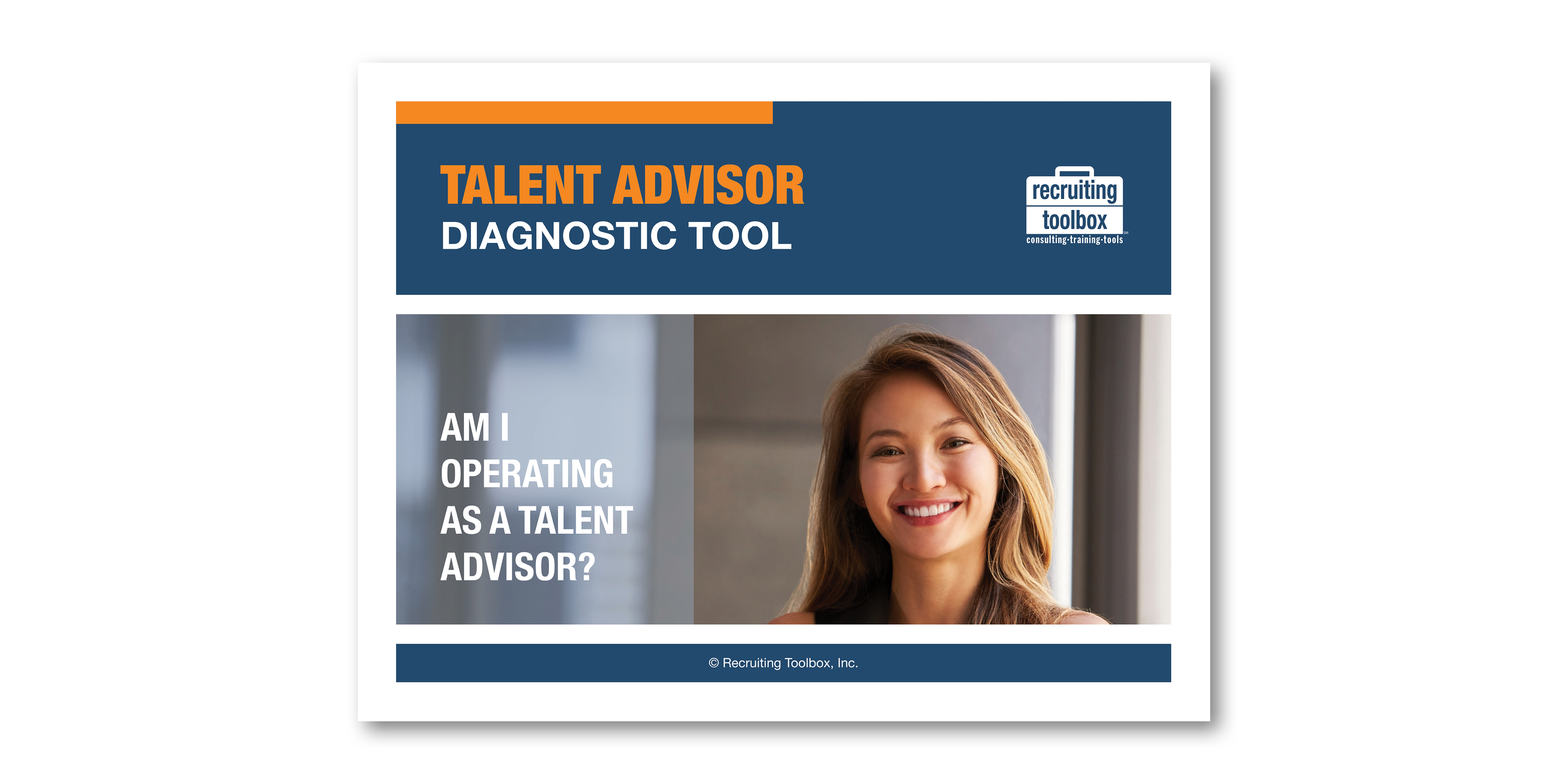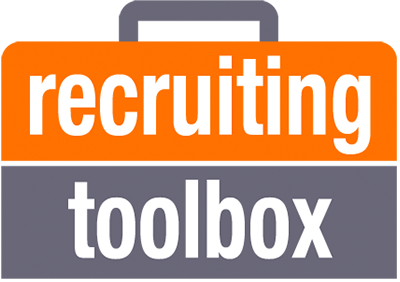Recruiting Toolbox Blog
How to be a Talent Advisor

[This blog post first appeared on the LinkedIn Talent Blog in May 2020]
While it’s always important for recruiters to keep their skills sharp, whenever reqs are put on hold it becomes even more critical. This means assessing where you are today, where you want to be, how to bridge the gap, and — critically — how to ensure your business understands your value.
I’ve found the most valuable thing recruiters can do for their business is deliver a strategic talent advisor experience. At Recruiting Toolbox, we’ve seen first hand (as former recruiting practitioners turned consultants and trainers) how much demand there is from hiring managers for us to operate more as talent advisors. To help you self-assess where you stand as an advisor, we’ve put together this free Talent Advisor Diagnostic Tool for you to download.
- Engaging your hiring manager
- Leveraging external insights
- Leveraging internal insights
- Having more strategic pre-sourcing conversations
- Getting more ROI from your sourcing strategy
- Building a more effective interview plan
- Making better hiring decisions
- Closing candidates more effectively
Once you’ve rated yourself on these eight areas and identified your opportunities for improvement, check out these resources below to up your game.
1. For engaging your hiring manager:
Anyone who tells you they know the secret sauce to great recruiting is likely trying to sell you something. But, if there is a secret sauce, it’s likely around how you engage hiring managers. Creating a culture of recruiting, where everyone — not just recruiters — sees their job as getting great talent into the org is the ultimate competitive advantage. For recruiters, that means engaging hiring managers effectively and providing real-time coaching at each stage of the recruiting process – from kicking off a requisition and screening candidates to interviewing and making the final decision about who to hire. The resources below can help you get started:
Resources:
- This summary of my 2019 Talent Connect talk details some steps you can take to make your role more strategic, including tips for creating a true partnership with your hiring managers.
- In this podcast with Matt Alder, I discuss the keys to engaging hiring managers in the recruiting process, with an emphasis on influencing their behavior.
2. For leveraging external insights:
Many recruiters have a keen understanding of the external market. Some of us have access to tools to help us — like LinkedIn Talent Insights — while others gain their insights from sourcing and screening candidates all day. As recruiters, we (should) know what’s going on — what companies we should target, how our job titles and compensation map to the market, what top talent wants, and what the available market looks like.
Bringing these “outside in” insights to the table will help position us as talent advisors. They’ll help us get invited into planning sessions, allow us to set expectations, and, if we’re lucky, we’ll get to create so many more PowerPoint decks (wink).
Resources:
- This article from Gartner shares how you can tell a more compelling story with your data.
- This story from an Autodesk recruiter (Autodesk is one of our clients) highlights how data can reshape hiring manager expectations and create trust.
3. For leveraging internal insights:
OK, how many years has every talent guru on the planet been telling us we need to know our data? 42. 42 years. But seriously, we must know our metrics to be successful talent advisors. What sources will generate the best quality and most diversity? What’s the average time to fill for this kind of req in this market? How many screens and interviews is it going to take to get those five hires made this quarter?
These are examples of important internal metrics we should know for our most critical jobs. They make us more credible when making recommendations, they allow us to push back when hiring managers are unrealistic, they allow us to influence strategy and process changes, and they give us even more opportunity to use Excel. I mean, who doesn’t want to be in XLS or Google Sheets, all day, everyday.
It’s unlikely your ATS produces perfect insights, ready to share. So, you’ll likely need to do some of your own heavy lifting. And it all starts with getting curious.
Resources:
- In this article about why curiosity might be the most important skill for recruiters, I share some strategies for fostering curiosity and asking the right questions.
- The Future of Recruiting Report contains a chapter on tracking and analyzing metrics that capture business impact.
4. For having more strategic pre-sourcing conversations:
When it comes to kickoff meetings, we need to lead two-way conversations, rather than just “take orders.” In fact, please do me a big favor, and remove “intake” from your vocabulary. Why? It’s so “order taker” to call it an intake.
Resources:
- In this blog post, I lay out why you should please stop calling it an intake.
- In this episode of Talent on Tap, LinkedIn’s head of recruiting, Brendan Browne, shares the checklist his team uses to run more successful strategy meetings and quickly gain credibility.
5. For getting more ROI from your sourcing strategy:
Do you know what sources generate the best, most diverse candidates for each of your critical roles? You should. Talent advisors employ the READY, AIM, FIRE approach — with an emphasis on AIM. Before we launch into sourcing, we should pause, and ask ourselves: What are the right outbound and inbound sourcing tactics I should employ for this role? How can my hiring manager help us generate leads and referrals? And lastly, are we better suited looking internally for talent?
Resources:
- This article details how you can leverage an effective but underused sourcing channel — internal hires.
- On our blog, I outline how we must update the questions we ask to get better referrals.
6. For building a more effective interview plan:
Throughout the hiring process, talent advisors co-create their interviewing strategy and plan with their hiring managers.
At the interview stage, this often involves determining the optimum number of interviewers and interviews to avoid false negative hiring decisions, bad candidate experience, and S L O W time to fill. Talent advisors know that misalignment is the root of all evil in recruiting, so they ensure all interviewers are prepared and aligned on “what good looks like,” have focus areas, and know their role in the process.
Resources:
- This article shows how a “Rule of Four” helped Google shave about two weeks off its time to hire, while still predicting new hire performance with a high degree of confidence.
- In this article, I discuss how to give every candidate a fair shot at the interview to help you avoid hiring decisions where you miss out on good talent.
7. For improving your decision-making process:
While the final decision about which candidate is hired is heavily driven by the hiring managers, recruiters who are seen as talent advisors often play a core role in keeping those decisions fair, objective, and transparent. We are not note takers - we are facilitators or part of the decision making process, bringing our own point of view to the hiring decision,
And sometimes, we lead by putting quality control mechanisms in place, like Bar Raisers or Debrief Facilitators from the business, so that we avoid both false positive (bad hire) and false negative (missed out on a good hire) hiring decisions.
Resources:
- Download the slides from my LinkedIn webinar on How to Raise the Bar on Talent, where I share the keys to driving alignment, and outline how companies have put quality control measures in place to avoid bad hiring decisions. Or, watch the webinar.
- This article highlights how four companies have improved their interviewing and decision making speed and quality.
8. For closing candidates more effectively:
Talent advisors have a deep understanding of their target candidate motivators. Investing time upfront to go beyond (ineffective) job description keywords and really understand the work — what will this person build, design, sell, scale, deliver, for example — will help them reframe the job around the IMPACT they will make, and better connect a candidate’s purpose to the opportunity.
Resources:
- Daniel Pink’s study on human motivation is a must read/watch — check out his video and learn why autonomy, mastery, and purpose are keys to framing up your job to speak to top talent.
- Join the (almost) 50 million people who have watched Simon Sinek explain his “Start with Why” approach to tapping into potential and motivating people to change.
Final thoughts: Hone your craft
Becoming a strategic talent advisor isn’t about thinking differently as much as it is about doing things differently. It takes courage and confidence to insert ourselves into conversations that maybe we weren’t part of in the past, to push back on unrealistic hiring managers, and to move out of note-taker mode and into point-of-view mode.
Honing our craft takes time and requires some risk taking. That’s something you can work on at any point, but if you have a little more bandwidth than usual right now, this is a valuable way to use your time. Not only can it improve your hiring process, relationships with hiring managers, and recruiting outcomes (more speed, more quality, more diversity) in the short term, but it’s one of the best ways to invest in yourself and your career.
Ping me on Twitter or LinkedIn if you have suggested resources to help elevate us all to true talent advisors. And sign up for our blog if you’d like to see more content like this.
Interested in Talent Advisor Training for your team of recruiters? Learn more here.
